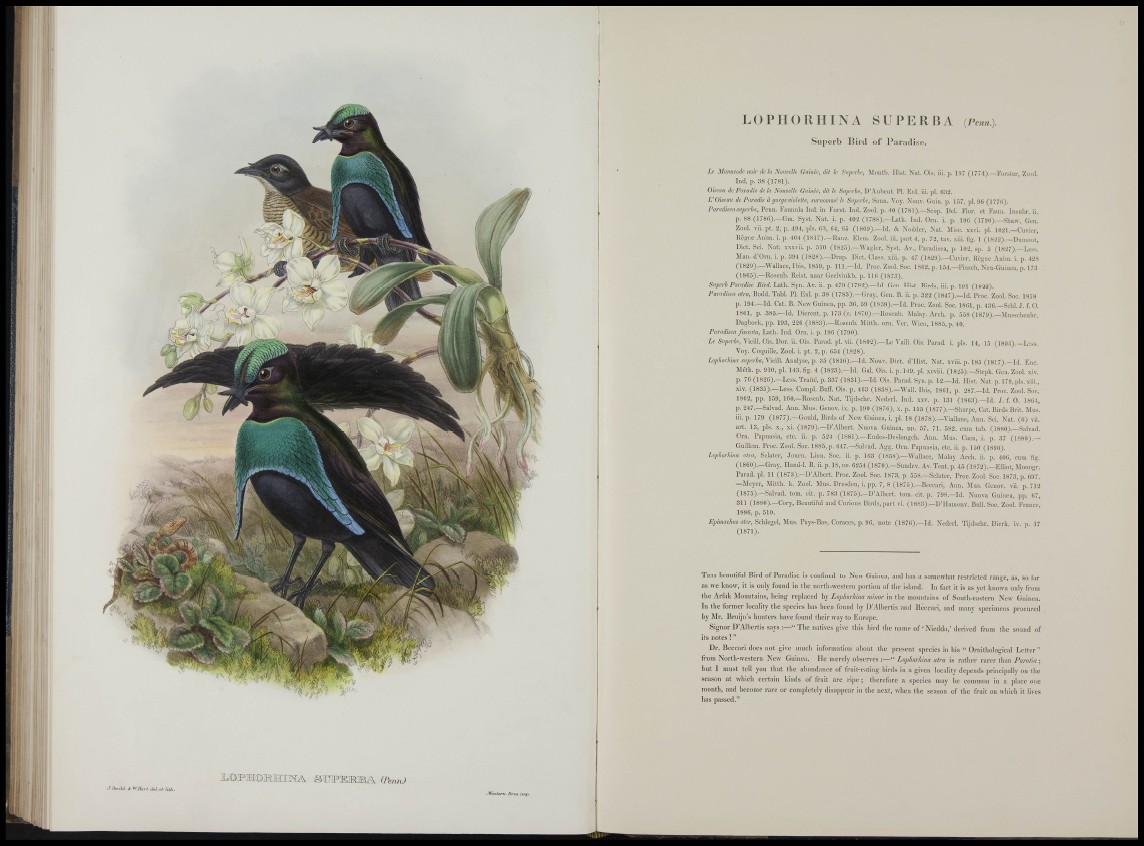
iír
lit 1
11,'i
il
^ 1 Ï
B f
i - D I ^ M O M H I K A . SOTMMJBi î . (/hmJ
J.OotiUi a- W.Hcxj-l, dtl.c/. (¿Ol.
. ffûUcm Bt-os. Í7nf>.
I t
L O P H O R H I N A SUP E R BA (/w).
Superb Bird of Paradise.
Le Mmmcoie noir delà Nouvelle Guink, dit le Siiperlc, Moiitb. Hist. Nat. Ois, iii. p. 1!I7 (1774).—Forster, Zuol.
Ind. p. 38 (1781).
Oiseau de Paradis delà Nouvelle Guinee, dit le Superbe, D'Aubeiit. PI. Eni. iii. pi. (i.'is.
VOiseau de Paradis à ¡¡orgeviolette, surnommé le Superile, Soiiu. Voy. Nouv. Guiii. p. 107, pi. OC (I77()).
Paradisea superba, Peun. Faunula Ind. in Forst. Ind. Zool. p. 40 (1781^.—Scop. Del. Fior, et FtWiii. Insul)r ii
p. 88 (178(i).—Gm. Syst. Nat. i. p. 40a (1788).—Lath. Ind. Orn. i. p. 1!)(¡ (17!)0).—Sliaw, Gcn.
Zool. vii. pt. 2, p. 49-1, pis. (Ì:Ì, (H, 05 (180!)).—Id. & Nodder, Nat. Mise. xxvi. pi. 10¿ICuvicr,
Rógne Anim. i. p. 404 (1817).—lìanz. Eleni. Zool. iii. part 4, p. 72, tav. xiii. fig. 1 (1822).—Dunmnt,
Diet. Sei. Nat. xxxvii. p. .«ilo (1825).—Wagler, Syst. Av., l'uiadisea, p. 102, sp. 5 (1827).—Less.
Man. d'Orn. i. p. 3g4 (1828).—Drap. Diet. Class, xiii. p. 47 (182!)).-Cuvier, Règne Anim. i. p. 428
(183!)).—Wallace, Ibis, 1850, p. 111.—]d. Proc. Zool. Soc. 1S02, p. 154.—riuscii, Neu-Gninea, p. 17:i
(18()5).—Rosenb. Reist. naar Geelviiikb. p. 110 (187:i).
Superb Paradise Bird, Lath. Syn. Av. ¡i. p. 479 (17S2).—Id, Gen. Hist. Birds, iii. p. 191 (1822).
Paradisea atra, Bodd. Tabi. Pl. Eni. p. ,38 (1783) .—Gray, Gen, B. ii. p. 322 (1847).—Id. Proc. Zool. Soc. 18.)8
p. 194,—Id, Cat, B. New Guinea, pp. 30, 59 (IS.'iO).—Id. Proc. Zool. Soe. 1801, p. 430.—Schl. J. f. O.
1801, p. 385.—Id. Dierent. p. 173 (c. 1S70) —Rosenb. Malay. Arch. p. 558 (1879).—Musschenbr.
Dagboek, pp. 193, 220 (18S3).—Rosenb. Mitth. orn. Ver. Wien, 1883,p. 40.
Paradisea fuscata. Lath. Ind. Orn. i. p. 190 (1790).
Le Superbe, Vieill. Ois. Dor. ii. Ois. Parad, pl. vii. (1802).—Le Vaili. Ois. Parad, i. pis. 14, 15 (1806).—Liss.
Voy. Coquille, Zool. i. pt. 2, p. 054 (1828).
LopliorUna S!í;)Crií!, VieiU. Analyse, p. 35 (1810).—Id. Nouv. Diet. d'IIist. Nat. xviii. p. 185 (1817).—IJ. Enc.
Méth. p. 910, pl. 143. fig. 4 (182,3).—Id. Gal. Ois. i. p. 149, pl. xcviii. (182,5).—Steph. Gen. Zool xiv.
p. 70 (1820).—Less. Traité, p. 337 (1831).—Id, Ois. Parad. Syn. p. 12.—Id. Hist. Nat. p. 179, pis. xiii.,
xiv. (1835).—Less. Compi. Buff. Ois. p. 403 (1838).—Wall. Ibis, 1801, p. 287.—Id. Proe. Zool. Soc.
1802, pp. 159, 160.—Rosenb. Nat. Tijdsehr. Ncderl. Ind. xxv. p. 131 (1803).—Id. J. f. 0 . 1804,
p. 247.—Salvad. Ann. Mus. Genov. ix. p. 190 (1870), x. p. 155 (1877).—Sharpe, Cat. Birds Brit. Mus.
iii. p. 179 (1877).—Gould, Birds of New Guinea, i. pl. 18 (1878).—Viallane, Ann. Sci. Nat. (0) vii.
a r t . 13, pis. X., xi. (1879).—D'Albert. Nuova Guinea, pp. 57, 71, 582, cura tab. (1880).—Salvad.
Orn. Papuasia, etc. ii. p. 5'24 (^1881).-—-Eudes-Dcslongcli. Ann. Mus. Caen, Í. j). 37 (^188()J.—
Guiìlem. Proc. Zuol. Soc. 1885, p. (i47.—Salvad. Á<¿g. Orn. Papaasia, etc. ii. p. 150 (1800).
Lophorhina ütixi, Sclater, Journ. Limi. Soc. ii. p, l(i3 (1858).—^Wallacc, Malay Arch ii. p 406 cum fie
(1800).—Gray, Hand-1. B. ii. p. 18, no. 0254 (1870).—Sundev. Av. Tent . p. 45 (1872).—Elliot, Monog°.
Parad, pl. 11 (1873).—D'Albert. Proc. Zool. Soc. 1873, p. 558.—Sclater, Proe. Zool. Soc. 1873, p. Wl .
—Meyer, Mitth. k. Zool. Mus. Dresden, i. pp. 7, 8 (1875),—Beecari, Ann. Mus, Gcnov. vii. p. 712
(1875).—Salvad, tom. eit. p. 783 (1875).—D'Albert, tom. eit. p. 798.—Id. Nuova Guinea, pp. 07,
311 (1880).—Cory, Beautiful and Curious Birds, par t vi. (1 883) .—D' l l amonv. Bull. Soc. Zool. France,
1880, p. 510.
£';n'fl!((c/i«s atee, Sehlegel, Mus. Pays-Bas, Coraces, p. 90, note (1870).-Id. Nederl. Tijdsehr, Dierk. iv. p. 17
(1871).
T i n s beautiful Bird of Paradise is confined to New Guinea, and lias a soraevvliat restricted range, as, so far
as we know, it is only found in the norlli-ivesteni ])ortion of tlic island. In fact it is as yet known only from
tlie Arfak Mountains, being replaced by Lop/iorldna minor in the mountains of South-eastern New Guiiieii.
In the former locality the species has been found hy D'Albertis and Beecari, and many specimens procured
by Mr. Brnijn's hunters have found their way to Europe.
Signer D'Albertis says The natives give this bird the name of ' Niedda," derived from tlic sound of
its notes!"
0 r . Beccari does not give much information about the present species in his " Ornitliological Letter"
from North-western New Guinea. He merely observes :—" Lnphorhina utra is rather rarer than Parotia ;
but I must tell you that the abundance of fruit-eating birds in a given locality depends principally on the
•season at which certain kinds of fruit are ripe ; therefore a species may be common in a place one
mouth, and become rare or completely disappear iu the next, when the season of the fruit on which it lives
has passed."